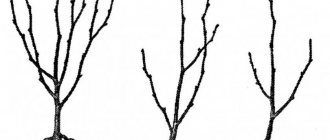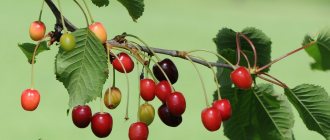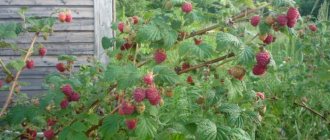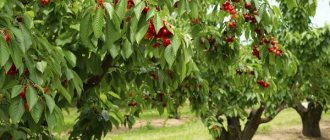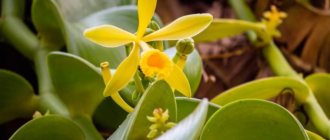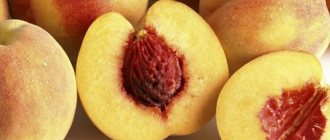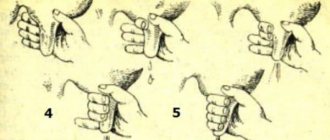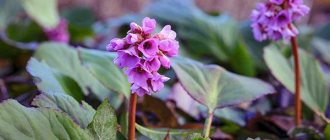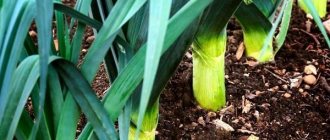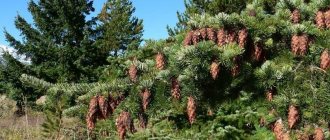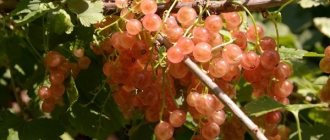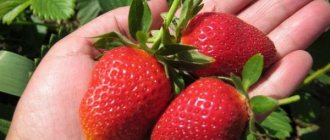Photo and description of the Vasilisa cherry variety
The Vasilisa cherry variety was bred through selection at the Artyomovskaya horticultural station by the famous agronomist of Ukraine L.I. Taranenko. The result was achieved by crossing the Donetskaya Krasvitsa and Donetsk Ugolyok varieties.
Among large-fruited varieties, Vasilisa cherry occupies one of the leading positions.
Mature tree height
An adult tree that has undergone regulation of the growth process reaches a height of up to four meters. Cherry is distinguished by arched strong branching, and its crown takes on a spherical appearance. The color of the shoots varies from light brown to dark brown. The ovoid-shaped leaves of the Vasilisa variety are distinguished by a glossy dark green tint.
Flowering and ripening period
Vasilisa blooms in April - May. The berries are picked as they ripen, when the cherries have already taken on a scarlet hue and a fleshy, juicy spherical shape. The size of the berries of the Vasilisa variety is large. Each fruit has an even round shape, with a shiny smooth surface, and a bright scarlet hue. The berries weigh up to 15 grams. The pulp is juicy, dense, sweet, with notes of wine flavor and a delicate aroma. The stone is easily separated from the pulp. The vitamin composition of the Vasilisa variety is rich and highly valued for its record content of potassium, calcium, magnesium and iron for cherries.
Harvesting is done carefully, because cherries are a delicate tree. The container for berries should not exceed a volume of five liters, otherwise the fruit may be compressed and crushed, leading to rapid spoilage and loss of presentation.
Productivity
Fruiting of a young tree begins in the second year of the plant’s life. Last year's growths and bouquet branches are the main places where ovaries appear. Ripening occurs in June, which is why the variety is considered mid-early. In cool summer conditions, ripening will begin in the first weeks of July. The method of care, soil and climate vary the yield of one adult tree from 20 to 50 kilograms of berries per season.
Transportability
The Vasilisa cherry variety tolerates transportation well. It is distinguished by its excellent presentation, which lasts a long time, so the sale is considered profitable. Widely used in industry as a raw material for compotes, confitures, preserves, jams and juices.
Drought resistance
The Vasilisa cherry tolerates dry periods well, but the plant is still moisture-loving and will not survive a long drought.
Frost resistance
With proper and timely mulching of the soil, cherries can withstand frost. It is recommended to whiten the trunk and also cover it with spruce branches to protect the tree from small pests.
Description
The tree has good growth vigor - from medium to strong. It is advisable to limit growth to a height of 4 meters during formation. Good branching forms a dense spherical crown. Vasilisa's shoots are thick, arched, but the curvature is not very pronounced, the bark is brown, and there is a moderate amount of lentils. The leaves are green, large, round-oval, short-pointed, with a wedge-shaped base and a serrated edge. The venation is delicate, the surface is matte. The petiole is normal and may have slight traces of anthocyanin coloring. The glands are small, colored, located near the base of the leaf. The cherry harvest is formed on bouquet branches and last year's growths.
The drupes of the variety are very large, weighing 11 - 14 grams. Externally, Vasilisa fruits are attractive, round in shape, dense, with a glossy shiny skin. The funnel is shallow and wide. The ripe berry is filled with a rich red color, the subcutaneous points are numerous and noticeable. The flesh is fleshy, quite dense, gristly, which can cause a crunch in the mouth, but at the same time juicy and aromatic. The taste is dessert, sweet, with sourness. Some call it sweet wine. The assessment of experts is high, but there are still disagreements. Some rate the taste at 4.25 - 4.5 points, others - at 4.5 - 5. The stone is quite large and separates well from the pulp. The stalk is not very long and is well attached to the fruit.
How to plant Vasilisa cherries
The Vasilisa variety is one of the most widespread in Ukraine. It prefers planting in loamy soils that retain water. The best time to plant seedlings is autumn, since the roots of the plant must have time to take root before the first winter frosts. The soil surface must be mulched with dry leaves and straw.
The Vasilisa cherry tree needs a lot of light and space to grow, so it is worth planting the shoots at a distance of five meters from each other, in areas abundantly illuminated by the sun.
How to choose a seedling
Seedlings are purchased from reliable, trusted owners. Young growth is grown for sale near the intended planting site so that the plant can be accepted, which is taken into account when purchasing. The seedling must have a graft, the trunk is strong and even, with a good crown.
It is worth choosing shoots with a closed root system, this will simplify planting throughout the season. If the roots are open, the young plants are soaked for 5–12 hours, and sprinkled with Ukorenite before planting.
Planting dates and scheme
The plant is placed in open ground in the fall. Choose the south side of the garden, where it is sunny most of the day. It is recommended to follow the following rules when planting Vasilisa:
- The planting hole is dug at a distance of at least five meters from the nearest trees - this is a prerequisite for the proper development of the plant.
- A layer of compost or humus is poured into the bottom of the hole.
- A low peg is driven in for greater stability of the seedling.
- Water thoroughly immediately after planting.
- Mandatory mulching with dry leaves and straw to avoid drying out of the soil and the growth of weeds.
Following simple tips when planting a plant will protect the gardener from problems with the tree in the future.
Pit preparation
The hole is dug to a depth of more than half a meter, about 80 cm wide. If the groundwater is too close to the surface, the bottom of the hole is compacted with an embankment and a drainage layer must be laid.
Landing rules
Future productivity depends on observing all the nuances when planting a tree. Therefore, it is important to follow the rules for planting a tree.
It is recommended to plant Vasilisa in the garden in early October or April. It is important to prepare the soil for planting in the spring. It is enriched with organic fertilizers and dug up. It is advisable to choose soil that has neutral acidity. The place should be sunny, not blown by winds. If possible, it is recommended to plant cherries near any structures on the southern or western side of the site. When planting cherries between trees, it is necessary to maintain an interval of 4 meters.
The landing pattern is as follows:
- dig a hole so deep that it reaches the root collar;
- drive a peg nearby to tie up a young tree;
- place the seedling in it at an angle of 45 degrees and straighten the roots;
- fill part of the hole with peat and organic fertilizers;
- In order for the root system to breathe well, it is recommended to fill the bottom of the hole with river sand;
- the seedling is covered with earth and compacted;
- water the soil;
- The tree is tied to a peg.
Caring for Vasilisa cherries
Caring for Vasilisa cherries is not difficult, because the variety is quite unpretentious. It includes the timely removal of dry old branches, leaves and unnecessary shoots. In the spring, the trunk is abundantly whitened from pests. In winter, it is recommended to cover the tree from below with branches of pine needles to avoid freezing of the roots.
Advice! A gardening trick is to tie a certain number of weights to the branches of the cherry tree. This procedure will help to form a spreading crown, which will greatly facilitate harvesting.
Feeding and watering
During the period of intensive growth of the Vasilisa variety, that is, in May, as well as during fruit set (June - July), abundant watering is carried out not at the root, but in the space around the trunk. The soil is saturated with moisture to a depth of more than 30 centimeters. The Vasilisa variety is demanding when it comes to feeding. The best time to apply fertilizer is spring and autumn.
Important! The last watering before the winter period requires moistening the soil to a depth of more than one and a half meters.
Weeding and loosening
The growth of seedlings is intense, so the young tree needs constant weeding from weeds and loosening of the top layer of soil. The tree trunk circle is increased to two to three meters. You should not go deep so as not to damage the root system.
Crown formation
Pruning is an important step in the life cycle of a healthy and strong tree. The Vasilisa variety branches, so the length of the young shoot is reduced by half during the formation of the crown in the spring. All dry branches, as well as those infected with pests and diseases, must be strictly removed.
Important! Pruning is done before the first buds swell on the tree.
Pollinators of the Vasilisa cherry
The Vasilisa cherry variety is a self-sterile hybrid, which is why it requires nearby pollinators. The latter varieties have proven themselves to be excellent:
- Homestead;
- Drogana yellow;
- Burlat;
- Valery Chkalov;
- April;
- Skorospelka;
- Valeria;
- Annushka;
- Starking;
- Bigarro is early;
- Donetsk coal;
- Bagration;
- Melitopol early.
The difference between the listed types is the aromatic qualities that complement Vasilisa. Gardeners fell in love with the Annushka variety, which adds notes of spice.
Growing technology
Cherry is a capricious fruit crop. For the survival of seedlings, the development of trees and high yields, it is important to choose the right place and timing of planting and provide the plants with care.
Optimal conditions
Vasilisa grows in loose, light, fertile soil with neutral acidity and moisture and breathability.
Reference. Lime or dolomite flour is added to acidic soil in advance at the rate of 300-500 g of the substance per 1 m².
When purchasing seedlings, choose 1- or 2-year-old specimens with an even, smooth trunk of 2 cm in diameter, 3-4 branched shoots, swollen, elastic buds and a developed, not dry root system.
Immediately before planting, the roots are soaked in a mixture of water, clay and a growth stimulant (Kornevin, Epin), the central trunk is cut to 80 cm, the side shoots to 20 cm.
Landing dates and rules
Cherry trees are planted in the spring, when the soil warms up to +5°C, or in the fall, about 1.5 months before frost (late September - early October).
For Vasilisa, choose a lighted, sunny place, protected from gusty winds, on a slope in the south or southwest direction, where melt and rainwater do not accumulate. The depth of groundwater is at least 2.5 m.
Planting technology:
- 2 weeks before planting, in an area dug up and cleared of plant debris, dig planting holes with a diameter of 0.6-0.8 m and a depth of 0.5-0.7 m every 3.5-4 m.
- Place a drainage layer of gravel or broken brick no more than 20 cm thick at the bottom of each.
- Place a nutrient mixture on top (1 part each of peat, humus, river sand and fertile soil layer, 40 g of superphosphate and 500 g of wood ash).
- Drive support stakes on both sides of the center of the pit.
- Form a hill of soil mixture in the hole, place a seedling on it, spreading the roots along the slopes.
- Cover the seedling with soil so that there are no voids around the roots, and the root collar is flush with the soil surface or 5 cm higher.
- Compact the soil and form an irrigation furrow.
- Water the plants at the rate of 10 liters of water for each.
- Mulch the tree trunk circle.
- Tie the seedling to the support with elastic clamps.
Other varieties of cherries, cherries, cherry plums or berry bushes are planted next to Vasilisa. Undesirable neighbors are nightshade crops, conifers, tall fruit and ornamental trees.
Further care
In case of sufficient rainfall, trees are watered 3 times per season:
- during the growing season and flowering (April - May) - 15-20 liters of water;
- at the beginning of fruiting (early June) - 15-20 liters of water;
- before winter (late September - early October) - 30-40 liters of water, so that the soil is saturated with moisture to a depth of 70-80 cm.
In case of drought, they focus on the condition of the soil, preventing it from drying out. On average, watering is carried out every 3-4 days at the rate of 10-15 liters per tree.
To avoid cracking of the berries, stop watering 2 weeks before harvest.
Reference. Cherries are watered not at the root, but in ring furrows around the perimeter of the crown.
They begin to feed Vasilisa 2 years after planting the seedlings, adding a urea solution (30 g per 10 liters of water) into the irrigation furrow. After 4 years of active fruiting, fertilizers are applied 2 times per season:
- April – 300 g of dry urea;
- September – 300 g of superphosphate and 100 g of potassium sulfate.
It is acceptable to add compost or rotted manure. Fresh organic matter will burn the roots of the trees.
Every year the tree trunk is whitewashed to a height of 1.2 m with a lime-clay mixture. This protects plants from pests and fungal diseases.
Every spring the crown is pruned, removing damaged, frozen shoots growing inward. Formation begins from the first year of tree life: side branches are shortened by 20 cm, skeletal branches are made shorter than the central shoot by 15 cm, and branches growing at an acute angle to the trunk are cut out.
When forming the crown in tiers, the distance between them should be 60-70 cm.
Possible problems, diseases, pests
Diseases and pests dangerous to Vasilisa are presented in the table.
| Disease/pest | Signs | Treatment/prevention |
| Moniliosis | The eyelids dry out, look burnt, and the berries rot. | Treatment with copper sulfate, Nitrophen, Horus. For prevention, trunks are whitened in the fall. |
| Cytosporosis | Dark spots appear on the bark, branches become brittle. | Infected parts of trees are removed with a sharp, sterile instrument. |
| Gum | A viscous amber-colored liquid appears on the cracks of trees. | To eliminate the possibility of fungi and viruses entering through cracks, they are treated with copper sulfate for disinfection and covered with garden pitch. |
| cherry fly | Holes are visible on the skin of the berries, the pulp becomes loose. | The plants are treated twice (with an interval of 10 days) with insecticides, for example, “Fury”, “Confidor”, “Fufanon”, “Aktellik”. |
| Cherry shoot and fruit moth | Small caterpillars can be seen on trees. | Treating trees with an infusion of wood ash, soap shavings and vinegar. |
To protect the berries from birds, the crown is covered with a special net, and stuffed animals are installed in the garden.
Wintering
Trees do not need winter shelter. Preparation for winter consists of abundant moisture-replenishing watering in the fall, after which the trunk circle is loosened and mulched, and the trunk is wrapped with mesh and agrotextiles to protect it from rodents.
Reproduction
Vasilisa is propagated by cuttings or grafting. In the first case, there is a high yield of seedlings, but a fruit-bearing tree from a cutting will grow in at least 5 years.
Grafting is the most effective way to quickly obtain high-quality seedlings. Mature cuttings are grafted onto strong mature trees. This also helps to improve the taste of berries, increase productivity and resistance of trees to frost and disease.
Features of cultivation depending on the region
Vasilisa grows successfully in the southern regions and temperate latitudes. In the northern regions, whose climate is characterized by long and frosty winters, the variety is not cultivated due to the high risk of seedling death.
Vasilisa's care requirements do not depend on the growing region. Only the time of planting seedlings varies: in the middle zone it is carried out in the spring, before the start of sap flow, in the south - in the fall, at the end of September.
Diseases and pests of Vasilis cherries
Minilliosis, coccomycosis and fruit rot do not affect Vasilisa cherries if regular prevention is carried out by spraying the plant with fungicides. The cherry fly can cause harm. This is a brown insect with a body length of 5 mm that lays eggs directly into cherry fruits. The larvae feed on the juicy pulp, causing the berries to rot and fall off. You can avoid pest infestation by loosening the soil around the trunk. If there are a lot of parasites, it is advisable to treat with insecticides, but no later than 20 days before harvest.
During the period of fruit ripening, protecting the tree from feathered pests becomes important. It is good to use various garden scarecrows, or throw special nets over the crown.
Characteristics
- Vasilisa enters the fruiting period 4-5 years after planting, and these are good indicators of precociousness;
- In the conditions of Donbass, the harvest can be harvested as early as June 15-20, which is slightly earlier than Krupnoplodnaya. In cooler regions, the fruits will ripen by early July;
- The yield is good - on average, you can harvest up to 30 kg of cherries from one tree. According to other sources, this figure is 2 times higher - up to 60 kg;
- fertile age lasts up to 20 years;
- The frost resistance of the variety is average - lower than that of Drogana yellow, but higher than that of Valery Chkalov. In the conditions of Donbass, the frost resistance of flower buds is insufficient;
- but the drought resistance of an adult plant is excellent, but long periods of drought will not benefit the tree;
- immunity is good, the variety is highly resistant to coccomycosis, successfully resists moniliosis and fruit rot;
- during periods of prolonged rains, 10 - 20% of the fruits may crack;
- the dense consistency of the berries increases their transportation characteristics, the fruits do not wrinkle or flow;
- The purpose of the fruit is dessert. But cherries are suitable for processing into confiture, jam, and compote.
Processing Vasilisa cherries in spring
Vasilisa cherries are processed in early spring, but always before the temperature rises above 14–16° C. The following chemical mixtures are used for spraying:
- Borodskaya (3%);
- Burgundy (3%);
- Horus;
- Strobe;
- Tilt;
- Speed;
- Aktofit.
Feeding is carried out in spring and autumn. Use drugs containing:
- nitrogen;
- potassium;
- phosphorus.
It is also recommended to feed a three-year-old tree with urea once (25–30 g of urea are dissolved in 10 liters of water). From the fourth year, urea is poured into the hole in a volume of up to 300 g. Every two years, the tree is fertilized with 40–50 kilograms of compost. You can use humus. Mineral fertilizer is applied annually - superphosphate (400 g) and potassium salts (200 g).
Harvesting and storage
They prepare for harvesting in advance: even before the fruits begin to ripen, they stop watering to protect the berries from cracking. When the fruits acquire a rich and even color tone, they are ready for harvesting. For transportation and storage, it is better to prepare wooden or plastic boxes with ventilation holes, not deep ones. The thinner the layer of fruit, the better for its integrity. Cherries are plucked with the stem removed to prolong their storage. Fresh berries are stored at a temperature of +1...+3°C for no more than 3–5 days.
Vasilisa is a highly productive cherry variety with an excellent berry taste. The crop can easily withstand transportation over long distances, maintaining its presentation.
Culture propagation
The Vasilisa variety can be propagated using cuttings, seeds and grafting.
Using bones
Propagating a tree using seeds usually results in cherries with inedible fruits. This method is used for growing rootstocks that are compatible with any variety.
Grafting
This method requires rootstock and cuttings. Cuttings are harvested in the fall. The rootstock is a shoot. 10-14 days before active sap flow, cuts up to 4 cm are made on the scion and rootstock. Afterwards, they are connected to each other in a lock and secured with tape. For effective engraftment, cuttings with two buds of the same thickness as the rootstock at the grafting site are required.
Cuttings
It is necessary to prepare material for planting - seedlings with growth buds measuring approximately 25 cm and a mixture of sand and peat in a 1:1 ratio. The cuttings are kept in a growth activator for approximately 10 hours. Afterwards, they are transplanted into a greenhouse, deepening to 4-5 cm in increments of 4-6 cm. Care consists of periodic watering and maintaining a temperature of 24-29 C. Roots are formed within 20 days.
